Serving 978 students in grades 6-8, Lakeside Middle School ranks in the bottom 50% of all schools in New Jersey for overall test scores (math proficiency is bottom 50%, and reading proficiency is bottom 50%).
The percentage of students achieving proficiency in math is 6% (which is lower than the New Jersey state average of 36%). The percentage of students achieving proficiency in reading/language arts is 13% (which is lower than the New Jersey state average of 49%).
The student:teacher ratio of 10:1 is lower than the New Jersey state level of 11:1.
Minority enrollment is 72% of the student body (majority Black), which is higher than the New Jersey state average of 62% (majority Hispanic and Black).
Quick Stats (2025)
- Grades: 6-8
- Enrollment: 978 students
- Student:Teacher Ratio: 10:1
- Minority Enrollment: 72%
- Overall Testing Rank: Bottom 50% in NJ
- Math Proficiency: 6% (Btm 50%)
- Reading Proficiency: 13% (Btm 50%)
- Science Proficiency: 2% (Btm 50%)
- Source: National Center for Education Statistics (NCES), NJ Dept. of Education
Top Rankings
Lakeside Middle School ranks among the top 20% of public schools in New Jersey for:
Category
Attribute
Diversity
Percent Eligible For Free Lunch
School Overview
Lakeside Middle School's student population of 978 students has declined by 8% over five school years.
The teacher population of 101 teachers has grown by 27% over five school years.
Grades Offered
Grades 6-8
Total Students
978 students
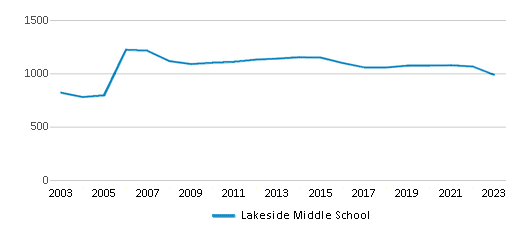
Gender %
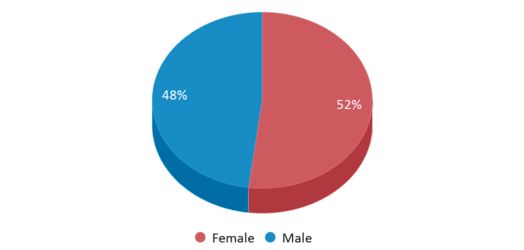
Total Classroom Teachers
101 teachers
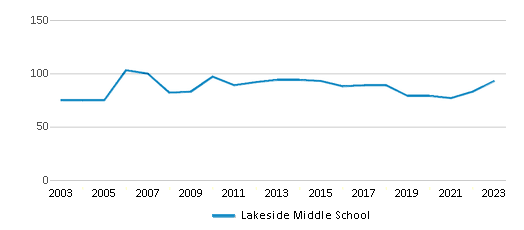
Students by Grade
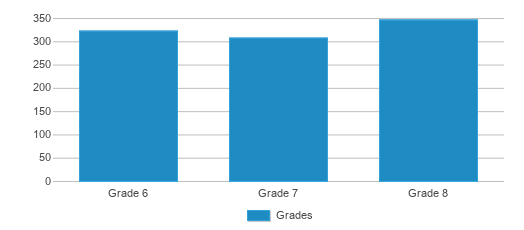
School Rankings
Lakeside Middle School ranks within the bottom 50% of all 2,201 schools in New Jersey (based off of combined math and reading proficiency testing data).
The diversity score of Lakeside Middle School is 0.71, which is less than the diversity score at state average of 0.72. The school's diversity has stayed relatively flat over five school years.
Overall Testing Rank
#2129 out of 2201 schools
(Bottom 50%)
(Bottom 50%)
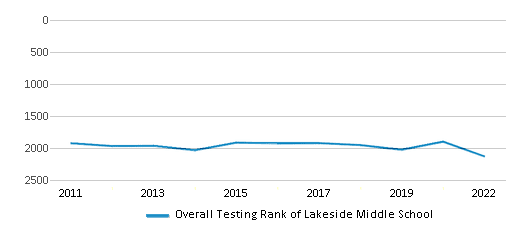
Math Test Scores (% Proficient)
6%
36%
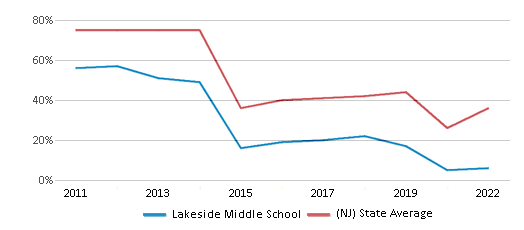
Reading/Language Arts Test Scores (% Proficient)
13%
49%
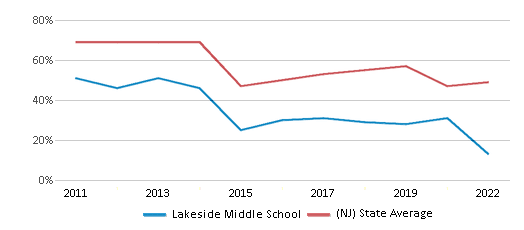
Science Test Scores (% Proficient)
2%
23%
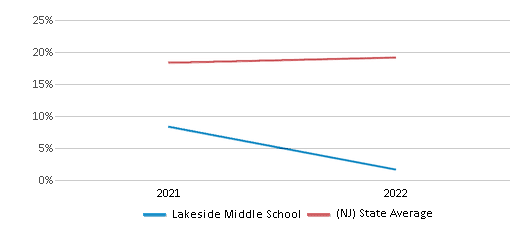
Student : Teacher Ratio
10:1
11:1
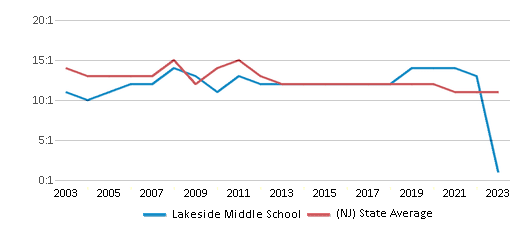
American Indian
n/a
n/a
Asian
1%
10%
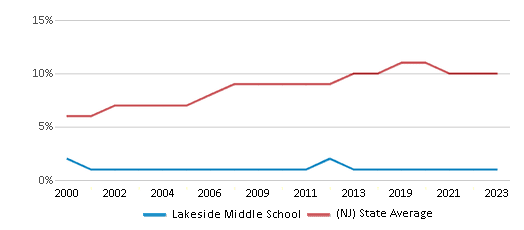
Hispanic
30%
34%
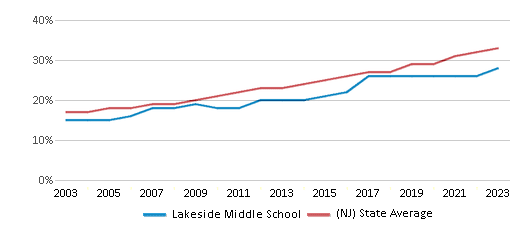
Black
35%
15%

White
28%
38%
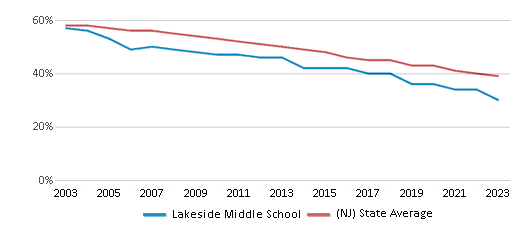
Hawaiian
n/a
n/a
Two or more races
6%
3%
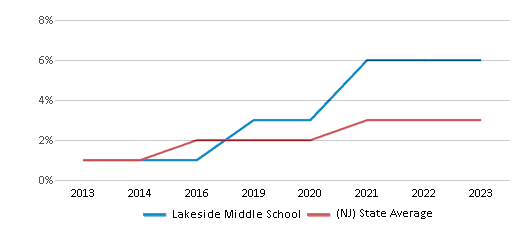
All Ethnic Groups
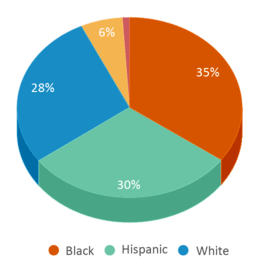
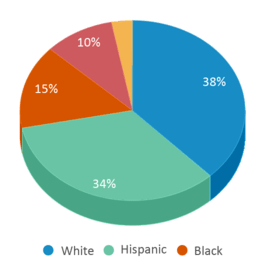
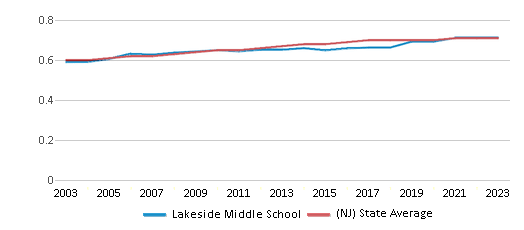
Eligible for Free Lunch
65%
32%
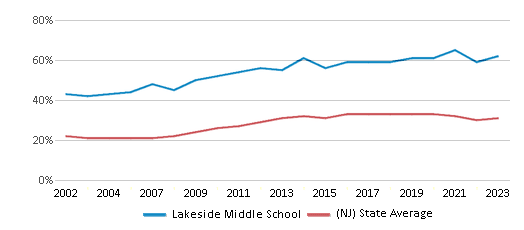
Eligible for Reduced Lunch
10%
6%
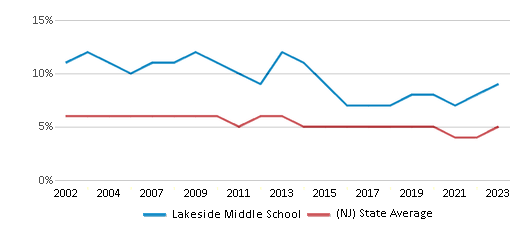
School Statewide Testing
School District Name
Source: National Center for Education Statistics (NCES), NJ Dept. of Education
Profile last updated: 02/09/2025
Frequently Asked Questions
What is Lakeside Middle School's ranking?
Lakeside Middle School is ranked #2129 out of 2,201 schools, which ranks it among the bottom 50% of public schools in New Jersey.
What percent of students have achieved state testing proficiency in math and reading?
6% of students have achieved math proficiency (compared to the 36% NJ state average), while 13% of students have achieved reading proficiency (compared to the 49% NJ state average).
How many students attend Lakeside Middle School?
978 students attend Lakeside Middle School.
What is the racial composition of the student body?
35% of Lakeside Middle School students are Black, 30% of students are Hispanic, 28% of students are White, 6% of students are Two or more races, and 1% of students are Asian.
What is the student:teacher ratio of Lakeside Middle School?
Lakeside Middle School has a student ration of 10:1, which is lower than the New Jersey state average of 11:1.
What grades does Lakeside Middle School offer ?
Lakeside Middle School offers enrollment in grades 6-8
What school district is Lakeside Middle School part of?
Lakeside Middle School is part of Millville School District.
School Reviews
5 5/17/2016
Lakeside Middle School is very nice. I am going to the 9th grade in 1 month, which means that I just left Lakeside in June. I have been there since 6th grade, and enjoyed it ever since. The teachers are very nice and push you to do your best. To be honest, there are students there that only have their minds set on drama and fighting. That's only about 5 students in each grade level that only want to fight. When I was at Lakeside, I didn't really care about my education. I only cared about seeing my friends. But, now that I''ve left, I really appreciate all of the teachers'' help. People say that Lakeside is a ghetto school, but it's really not. Mr.Denning, the principal, gave us important speeches about our goals in life. He thinks of new ideas all of the time to give us a better education, and for most of the students there, it really works and helps them. There are even students there who think of great ideas to make Lakeside an even better school than what it already is. So, if you''re thinking about applying your child to Lakeside Middle School, there isn't one reason why I would say no to that. To conclude this review, Lakeside Middle School is absolutely amazing and will make you and your child very happy. I hope this review helped. Thank you.
Review Lakeside Middle School. Reviews should be a few sentences in length. Please include any comments on:
- Quality of academic programs, teachers, and facilities
- Availability of music, art, sports and other extracurricular activities
Recent Articles

What Is A Charter School?
Explore the world of charter schools in this comprehensive guide. Learn about their history, how they operate, and the pros and cons of this educational innovation. Discover key facts about charter schools, including admission policies, demographics, and funding, as well as what to look for when considering a charter school for your child.

10 Reasons Why High School Sports Benefit Students
Discover the 10 compelling reasons why high school sports are beneficial for students. This comprehensive article explores how athletics enhance academic performance, foster personal growth, and develop crucial life skills. From improved fitness and time management to leadership development and community representation, learn why participating in high school sports can be a game-changer for students' overall success and well-being.

February 05, 2025
Understanding the U.S. Department of Education: Structure, Impact, and EvolutionWe explore how the Department of Education shapes American education, from its cabinet-level leadership to its impact on millions of students, written for general audiences seeking clarity on this vital institution.





